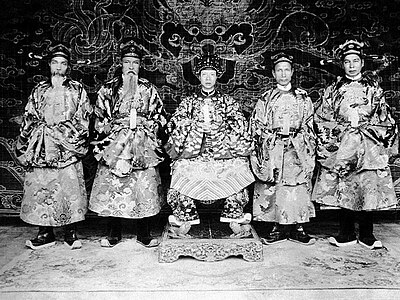Futou
| Futou/Putou | |||||||
|---|---|---|---|---|---|---|---|
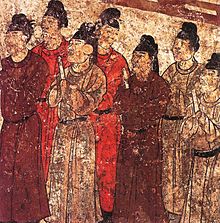 Eunuchs wearing yuanlingshan and futou, Tang dynasty | |||||||
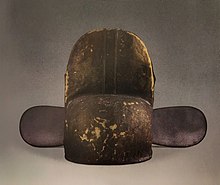 Wushamao (a type of futou), housed in Shanghai Museum | |||||||
| Traditional Chinese | 襆頭/幞頭 | ||||||
| Simplified Chinese | 幞头 | ||||||
| Literal meaning | Scarf head | ||||||
| |||||||
Futou (simplified Chinese: 幞头; traditional Chinese: 襆頭/幞頭; also pronounced and written as putou), also known as fu (幞) and toujin (
The futou was also introduced in both Unified Silla and Balhae[6]: 135 and continued to be worn by government officials until the late Joseon.[7]: 25 The futou with a jinzi (lining) was also introduced back in the Sogdian areas in Central Asia spreading to the Western regions through the Xinjiang region.[2] The futou with jinzi was also introduced in Japan during the Nara period through Prince Shōtaku.[2] Đại Cồ Việt was introduced to the futou in the late 10th century and adapted various iterations from the Early Lê to the Nguyễn dynasty.[8]: 171
Terminology
The term futou (or putou) (simplified Chinese: 幞头; traditional Chinese: 襆頭 or 幞頭) means "head scarf" or "head-cloth".[3]: 319 According to the Mufuyanxianlu by Bi Zhongxun, the original meaning of futou was to "cover one's head with a black cloth" before the Sui dynasty.[9]
The English term "feet", which is used to describe the hard ribbons used in the futou, is called jiao (simplified Chinese:
The jinzi (
History
Origins
There are varying opinions on the origins of the futou in the literature. According to Chinese scholar Sun Ji in From Futou to Turban (
Guzel Maitdinova proposed in 1990 that the futou may have been developed from hats worn in ancient Central Asia and was brought in by the Turks from Sogdiana to Tokharistan to China, based on information provided by Hsen Kuo, an 11th-century Chinese annalist:[11]: 54–55
"The Chinese clothes and hats, starting from the time of Northern Qi dynasty represents a barbarian costume".
It is also proposed by Yatsenko that the futou was part of the Chinese male costume.[11]: 54
Wei, Jin, Northern and Southern dynasties

The origins of the futou in China can be traced back to the reign of Emperor Wu in Northern Zhou,[2] who had wrapped his head with a futou with four ribbons, called sijiao (
The futou first appeared a type of kerchief made by cutting a piece of muslin fabric into the proper size and by attaching four long and wide ribbons at each corner of the fabric like four feet.[10]: 10 [2] This futou was large enough to cover all the hair of its wearer,[10]: 10 and when it was worn, a kerchief had to be placed on the top of its wearer's head.[2] Two of these ribbons were tied on the forehead while the other two were tied at the back of the wearer's head and was left hanging down.[2][10]: 10 Prior to the Sui dynasty, the futou was a black piece of cloth.[9]
Sui, Tang dynasty, and Five dynasties and ten kingdoms period
Tang dynasty
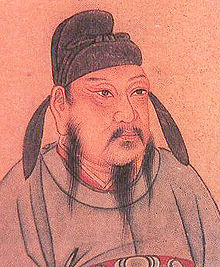

Prior to the Song dynasty, the futou was mostly made of black muslin.[10]: 11 In the early Tang, the futou was a sijiaoruanjin (
| Types of futou | Description | Pictures | |
|---|---|---|---|
| Ruanjiao putou
(软脚幞頭; 軟腳幞頭; ruǎnjiǎo fútóu; 'putou with soft legs') |
A typical type of headwear in the Tang dynasty and was an important precursor to the futou developed in the succeeding dynasties. Sometimes, 2 or 4 narrow and long ribbons were tied to the back of the putou and were allowed to hang down freely down the back of its wearer[3]: 319 | 
|

|
| Zheshang jin ( |
A type of form of ruanjiao putou which consisted of square-piece of cloth wrap around the head; the two ends of the fabric were then tied at the back at either side of the neck and were then wrapped around the head before being together above the forehead.[3]: 319 | 
|
|
| Chuijiao Putou ( |
A black hat with two drooped down wing-like flaps. | 
|
|
Five dynasties and ten kingdoms period
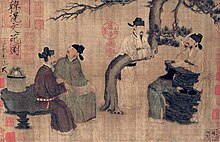
In the Five dynasties period, more styles of futou were created including the futou with wide feet which looked like fans or banana leaves which surrounded the front of the head; and the futou with curved feet which turned upwards before bending downward.[9]
In the Ma Chu, painted silk was used in the futou.[9] Ma Xifan also wore the horns of a dragon (Chinese: 龙角; pinyin: lóngjiǎo; lit. 'dragon horn'), a futou with extremely long feet on both sides.[9]
During the Later Jin, Emperor Liu Min used a zhijiaofutou with long and straight feet which were more than one foot in length; the Song dynasty later kept the tradition of using this style of futou as a standard.[9] It is also attested in the Song Shi that the futou had become straight and flat since the Five dynasties period.[9]
Song dynasty

The futou was popular in the Song dynasty,[5] and it was commonly worn all classes of people ranging from commoners to emperors wore futou.[10]: 11 During the Song dynasty, the black muslin, which was mainly used to make the futou, was replaced by other materials, such as muslin or lacquered muslin.[10]: 11 The futou could also be found with supports made out of wood, and therefore they could look like hats and caps of various styles.[5] Hard ribbons were also used;[10]: 10 and all the futou in this period had hard feet.[9] There were 5 main types of futou in this period: the zhijiaofutou (also called pingjiaofutou (Chinese:
According to the Song Shi, the zhijiaofutou became the national standard form of futou in the Song dynasty for the emperor and the officials on any occasion, except when they had to take a carriage.[9] The futou worn by the Song dynasty officials had an extended reclined feet; it was developed by having two hard ribbons made out with iron wire or bamboo strips attached at the back of the futou.[10]: 11 According to the Pedantic Remarks of the Confucians by Yu Yan, this form of futou might have been developed to prevent the officials from whispering to each other during court audience with the Emperor.[10]: 11 On some special occasions (e.g. the imperial court banquets, or the longevity ceremonies held for the royal family), Song court officials would put flowers on their futou; this was referred as Flower pinning.[10]: 11 The Song emperors would sometimes send fresh flowers or man-made flowers which were exclusive to the use of the imperial court to his courtier; this later become a form of etiquette in the Song dynasty court.[10]: 11 It is also recorded in the Song Shi that the upward futou was used by people (including the Emperor and the officials) when they found themselves in narrow spaces, such as in a carriage.[9]
According to the first volume of the History Narrated at Ease in the section The Etiquette by Wang Dechen (1036 –1116), in the early Song dynasty, a type futou, called front-folded scarf, was worn by some people.[10]: 11 The front-folded scarf was folded and tied at the front region of the head was worn by some people.[10]: 11 The back-folded scarf was a type futou which would be bent backward; it started to be worn after the Shaosheng period (i.e. after 1098 AD).[10]: 11 Following the Shaosheng period, there were many changes in the styles of futou.[10]: 11
There were also other forms of futou, such as the colourful flower-shaped futou embedded with gold lines which were sold in market of Dongjing; the curved-feet futou or the flower-like futou with feet curved backwards were also worn by some warriors; the long feet futou was favoured by the musical instrument plays of the imperial music office; the lustreless futou, and the white crêpe futou which was worn during funerals.[10]: 11
| Types of futou | Description | Pictures | ||
|---|---|---|---|---|
| Zhanjiao Putou |
It consisted of a black hat with two wing-like flaps which extends outward. The thin flaps were stiff and straight, and could extend up to almost a meter each. | 
|

|

|
Liao dynasty

In the Khitan-led Liao dynasty, the Khitans shaved their hair in a style called kunfa and wore light hats made of felt or helmets which were more suitable for their horse riding activities instead of wearing the lacquered futou; however the futou did not disappear in this period and continued to be depicted in the Liao dynasty tomb murals, including the curved leg futou.[9]
Yuan dynasty
In the Mongol-led Yuan dynasty, the futou continued to be worn since the Yuan dynasty court followed the Song dynasty standards regarding official costumes:[9]
(All officials’ work clothes should wear) straight tails painted hemp futou.
Ming dynasty / "Wushamao" (乌纱帽 )
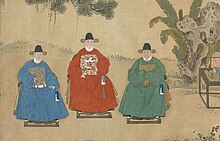

During the Ming dynasty, a type of futou was to be worn by government officials as part of the court uniform, called wushamao (乌纱
| Types of futou | Description | Pictures | ||
|---|---|---|---|---|
| Zhanchi Futou/putou ( |
It is a headwear of Ming dynasty officials, consisting of a black hat with two wing-like flaps of thin, oval shaped boards on each side. According to the Collected Statutes of the Ming Dynasty ( |
  
| ||
| Zhanjiao Putou ( |
It was based on the Song dynasty's zhanjiao putou; in the Ming dynasty, it was worn by Ming civil officials at court assemblies when they would present memorials or retirement notices to the Ming rulers.[3]: 100 |   
| ||

| ||||
| Yishan guan ( |
A type of futou made of lacquered silk which is formed on a wooden frame. At the back of the hat, there is a tall extension which is molded into 2 symmetrical bulbous shapes; there are 2 ribbons which are fastened to the hat's lower back and straight up extending just beyond the top protrusion.[3]: 102 It is also a type of guan. |  
| ||

|

|

| ||
Derivatives and influences
See also
Notes
References
- ^ "
廣 韻 :入聲 :燭 : 幞 -四 腳 - Chinese Text Project". ctext.org. Retrieved 2022-06-14. - ^ a b c d e f g h i j k l m n o Mai, Huijuan; Yang, Yimin; Jiang, Hongen; Wang, Bo; Wang, Changsui (2017-10-01). "Investigating the materials and manufacture of Jinzi: The lining of Futou (Chinese traditional male headwear) from the Astana Cemeteries, Xinjiang, China". Journal of Cultural Heritage. 27: 116–124. doi:10.1016/j.culher.2017.02.018. ISSN 1296-2074.
- ^ a b c d e f g h i Burkus, Anne Gail (2010). Through a forest of chancellors: fugitive histories in Liu Yuan's "Lingyan ge", an illustrated book from seventeenth-century Suzhou. Yuan, active Liu. Cambridge, Mass. p. 319. ISBN 978-1-68417-050-0. OCLC 956711877.
{{cite book}}: CS1 maint: location missing publisher (link) - ^ Dale R. Johnson (2020). A Glossary of Words and Phrases in the Oral Performing and Dramatic Literatures of the Jin, Yuan, and Ming. University of Michigan Center for Chinese Studies. p. 73. ISBN 978-0-472-03823-7. OCLC 1229843176.
- ^ a b c d e f Zang, Yingchun; 臧
迎春 . (2003). Zhongguo chuan tong fu shi [Chinese traditional costumes and ornaments].李 竹 润.,王 德 华., 顾映晨. (Di 1 ban ed.). Beijing: Wu zhou chuan bo chu ban she. ISBN 7-5085-0279-5. OCLC 55895164. - ^ A new history of Parhae. John B. Duncan, Tongbuga Yŏksa Chaedan, Tongbuga Yo⁺їksa Chaedan. Leiden: Global Oriental. 2012. ISBN 978-90-04-24299-9. OCLC 864678409.
{{cite book}}: CS1 maint: others (link) - ^ Encyclopedia of Traditional Korean clothing. Vol. VI (English ed.). Seoul: National Folk Museum of Korea. 2021. ISBN 9788928902873.
- ^ One Thousand Years of Caps and Robes. Vol. I (Vietnamese ed.). Vietnam: Hanoi: World Publishing House. 2013.
- ^ a b c d e f g h i j k l m n o p q r s t u v w Ren, Baihua (2020). The Water Mill: authentication and analysis of an ancient Chinese Jiehua painting (PhD thesis). University of Glasgow.
- ^ a b c d e f g h i j k l m n o p q r s t u v Zhu, Ruixi;
朱 瑞 熙; Bangwei Zhang, Fusheng Liu, Chongbang Cai, Zengyu Wang, Peter Ditmanson, Bang Qian Zhu (2016). A social history of middle-period China: the Song, Liao, Western Xia and Jin dynasties (illustrated ed.). Cambridge, United Kingdom. ISBN 978-1-107-16786-5. OCLC 953576345.{{cite book}}: CS1 maint: location missing publisher (link) CS1 maint: multiple names: authors list (link) - ^ a b Stepanov, T︠S︡vetelin (2010). Bulgars and the Steppe Empire in the Early Middle Ages: The Problem of the Others. Leiden, Netherlands: Brill Publishers. ISBN 978-90-474-4452-7. OCLC 695988846.
- ^ "
通 典 :禮 十 七 :幅 巾 - Chinese Text Project". ctext.org. Retrieved 2022-06-14. - ^ a b "
朱子 語 類 :禮 八 :雜 儀 - Chinese Text Project". ctext.org. Retrieved 2022-06-14. - ^ "67". History of the Ming.
文武 官 常 服 :洪 武 三 年 定 ,凡常 朝 視 事 ,以烏紗 帽 、團 領 衫、束帶 為 公 服 。 - ^ 薛天纬,“乌纱
帽 ”小 考 ,《学林 漫录》六 集 - ^ "郑州
日 报:乌纱帽 的 变迁". Archived from the original on 2008-05-06. Retrieved 2013-11-04.




